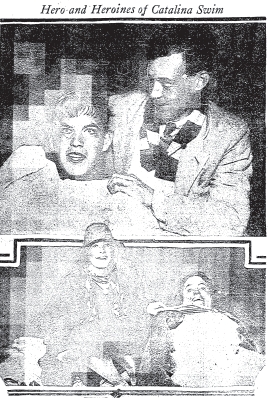January 16, 1927
Palos Verdes Peninsula, CA

In 1919, the heavily insured William Wrigley Jr. bought a controlling interest in the Santa Catalina Island Co., and sought to promote his lovely little island getaway. And what better publicity stunt for the Roaring 20s than a contest of endurance? Yes, a winter swim from Catalina to Point Vicente would be just the thing for those flagpole-sitting, dance marathoning types.
Wrigley offered a prize of $25,000 to the first man to finish the January 15 channel swim, and $15,000 to the first woman.
The Wrigley Ocean Marathon attracted over 100 competitors, including a 17-year-old Canadian boy named George Young. Young held several Canadian swimming records, but was too poor to afford a ticket to Los Angeles. He did, however, have a friend with a motorcycle, and together they made the long haul from Toronto. The bike broke down in Arizona, where Young was picked up by a honeymooning couple, who drove him the rest of the way.
His perserverance paid off. Around 3am on January 16, after swimming for nearly 16 hours, Young was declared the winner of Wrigley’s challenge. In fact, he was the only competitor to finish the race. With water temperatures hovering in the 50s, over 2/3 of the contestants dropped out after just a few hours.
Young caused a stir when he emerged from the surf in the nude. The modest Young said, "We put a covering of graphite over the grease before I put on my bathing suit to help keep out the cold… I had taken off my bathing suit when I was two and one half miles from Catalina, and I forgot that grease and graphite were my only covering as I rose out of the water."
Two women, Margaret Hauser of Long Beach and Martha Stager of Portland, OR, were awarded prize money, despite not completing the race. Only a mile from the finish line, Hauser was pulled from the water by her husband/trainer after 19 hours and 26 minutes, making her the contestant who lasted the longest. When Wrigley heard the news, he said, "Shucks! That’s too bad. Give them each $2500 for their remarkable attempts."
Sadly, Young’s career fell apart soon after the race. His manager turned down a $250,000 movie offer, believing he could get more money. But there weren’t any other offers, and Young never again recaptured his glory he enjoyed as "The Catalina Kid."
Those interested in the endurance contests of the era may also enjoy Geoff Williams’s new book, C.C. Pyle’s Amazing Foot Race, which recounts the misadventures of the 199 men who ran from Los Angeles to New York City in 1928.
